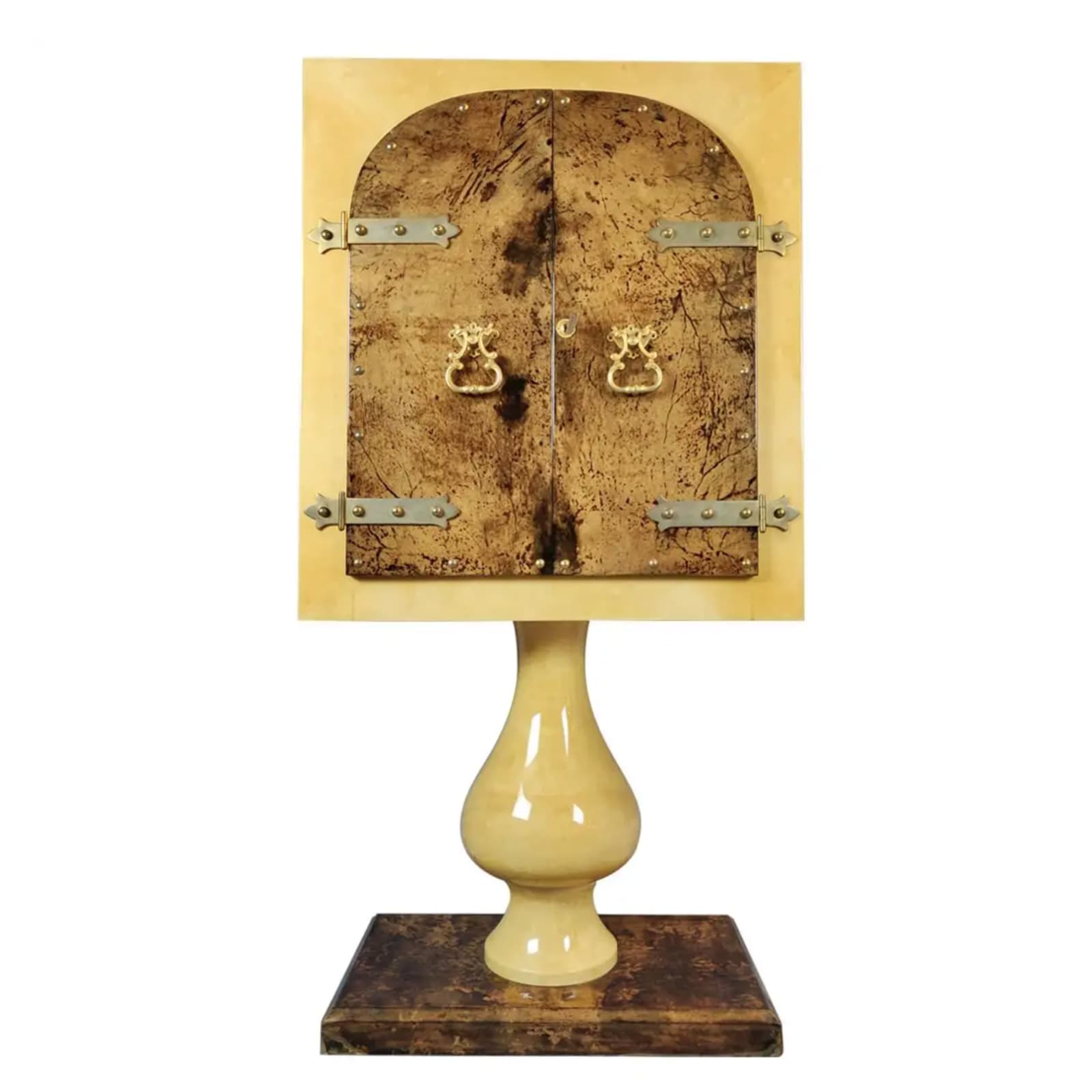-
Artworks
Aldo Tura
Exquisite illuminated bar cabinet with Goatskin, 1950Wood, mirror, glassH157 × W81 × D40cmFurther images
图拉设计的酒柜,材质为实木,玻璃,金属及山羊皮,于1950年代在意大利制造。这件柜子可以作为吧台背后的展示酒柜或独立的储物柜来使用。独特的花瓶底座注定了这个酒柜的与众不同。鲜黄色的实木柜体与姜黄色的、带有斑驳质感的山羊皮包裹着的柜门形成强烈的对比,其特别之处还在于表面的高亮涂层使得两种黄色完美融合,相互配合,造就了一个经典之作。柜体内部配有灯光及镜子,既保证了柜内良好的视觉效果,也在复古经典中增添一些现代的混合元素使得镜子与灯光的搭配更加相得益彰。 A Tura-designed wine cabinet in solid wood, glass, metal and goatskin, made in Italy in the 1950s. This cabinet can be used as a display wine cabinet behind the...图拉设计的酒柜,材质为实木,玻璃,金属及山羊皮,于1950年代在意大利制造。这件柜子可以作为吧台背后的展示酒柜或独立的储物柜来使用。独特的花瓶底座注定了这个酒柜的与众不同。鲜黄色的实木柜体与姜黄色的、带有斑驳质感的山羊皮包裹着的柜门形成强烈的对比,其特别之处还在于表面的高亮涂层使得两种黄色完美融合,相互配合,造就了一个经典之作。柜体内部配有灯光及镜子,既保证了柜内良好的视觉效果,也在复古经典中增添一些现代的混合元素使得镜子与灯光的搭配更加相得益彰。
A Tura-designed wine cabinet in solid wood, glass, metal and goatskin, made in Italy in the 1950s. This cabinet can be used as a display wine cabinet behind the bar or as a stand-alone storage unit. The unique vase base makes this wine cabinet unique. The contrast between the bright yellow solid wood cabinet and the ginger, mottled goatskin wrapped doors is exceptional as the high gloss finish allows the two yellows to blend and complement each other to create a classic piece. The interior of the cabinet is lit and mirrored, ensuring a good visual effect inside the cabinet, but also adding a modern mix of vintage classics to make the mirror and lighting complement each other.
关于设计师
阿尔多·图拉是一位意大利家具设计师,他最出名的作品是上世纪中叶生产的桌子和灯具。他把对装饰艺术和新艺术的兴趣与20世纪40、 50年代的极简主义设计结合起来,因其突破性地使用羊皮纸、蛋壳和山羊皮等不同寻常的材料设计家具,被称为“羊皮纸大师”。
图拉于1939年在意大利伦巴第建立了他的家具生产厂,风格游走于装饰艺术和现代主义之间,创造了许多独特的高端家具,其作品典型特征是丰富的材料,雕塑般的形式,以及高端的工艺。因其极具异国情调的家具表面处理工艺,以及对红色、绿色和黄色等艳丽色彩的运用,图拉的作品在国际市场上被广泛认可,极具收藏价值。
Aldo Tura was an Italian furniture designer best known for his tables and lamps produced in the middle of the last century. Combining his interest in Art Deco and Art Nouveau with the minimalist designs of the 1940s and 1950s, he became known as the 'Master of Parchment' for his groundbreaking use of unusual materials such as parchment, eggshell and goatskin to design furniture.
Tula established his furniture factory in Lombardy, Italy, in 1939, and his style straddled the line between Art Deco and Modernism, creating a number of distinctive pieces of high-end furniture, typically characterised by rich materials, sculptural forms, and high-end craftsmanship. Tula's work is widely recognised on the international market as highly collectible due to its exotic furniture finishes and use of bright colours such as red, green and yellow.










